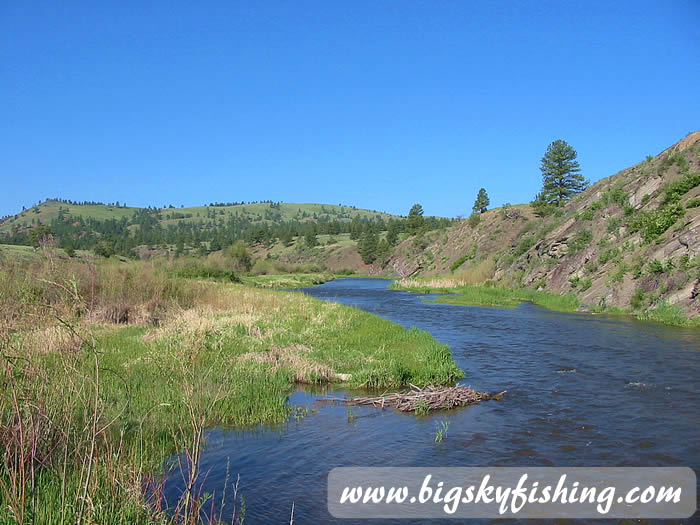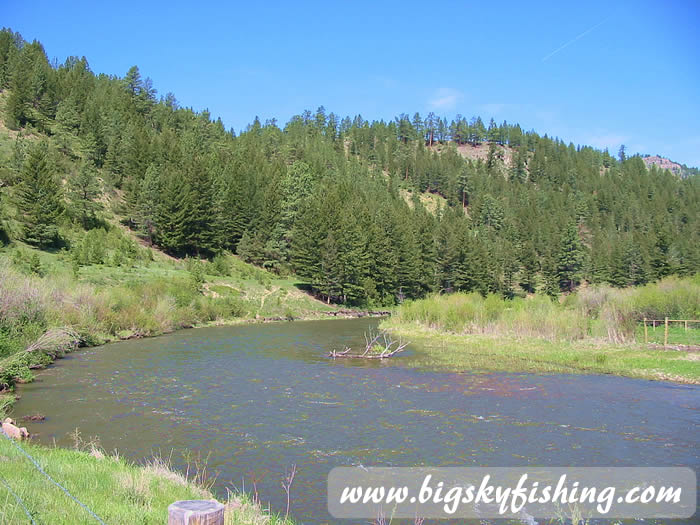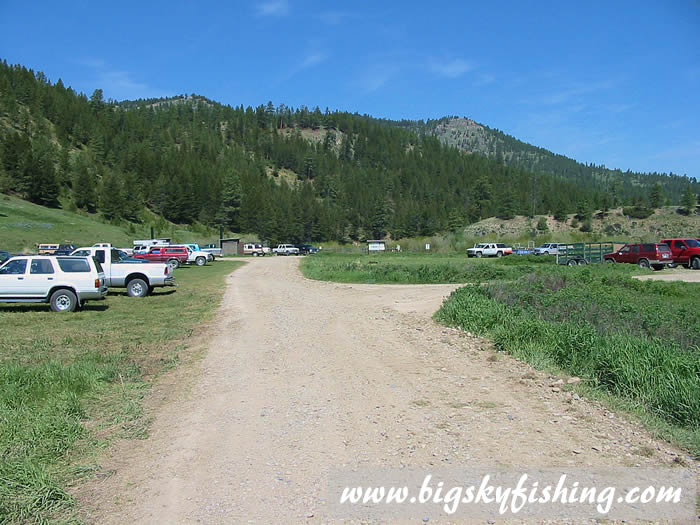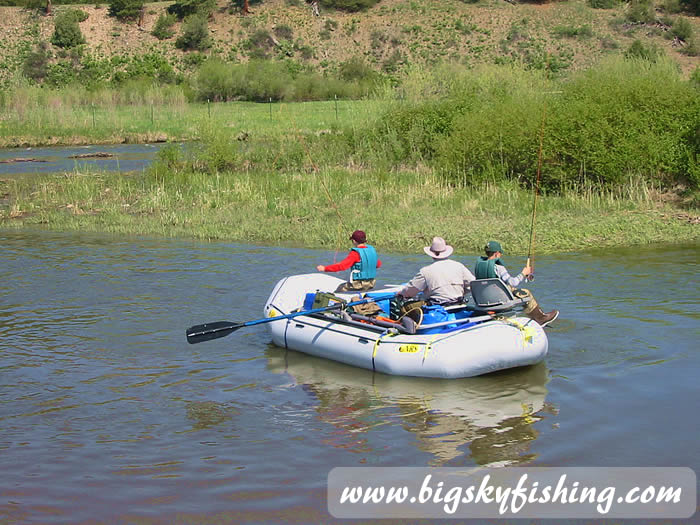Overnight Fly Fishing Trips on the Smith River
Experience the beauty of the Smith River canyon while camping in style. Montana Angler Fly Fishing custom designs overnight float trips, lodging packages and wilderness pack trips on multiple world class rivers, spring creeks and private ranches. Outfitter #10770
Overnight Trips on the Smith River
Experience the beauty of the Smith River canyon while camping in style. Outfitter #10770.
The Smith River is one of the finest rivers in Montana. Superb fishing, gorgeous scenery and remote setting combine to make a Montana fly fishing trip on the Smith River an unforgettable experience.
 |
| Smith River |
Unfortunately, gaining access to the river is difficult. The Smith flows through private land for most of its length. Due to a lack of fishing access sites, wade fishing is difficult. Consequently, the most popular and effective way to fish the Smith River is by boat.
Unlike other Montana rivers, anyone who wants to float the Smith needs a permit. Each February a drawing for permits is held, with a limit of 9 float parties allowed to put in on any given day. As a result, while access to the Smith River is difficult, the regulations moderate fishing pressure and allow for long floats in relative solitude.
Introduction
The Smith River begins near White Sulphur Springs, Montana, at the confluence of the North and South Fork Smith River. The river then twists and turns for more than 100 miles through remote and scenic landscapes before spilling into the Missouri River near Ulm, Montana.
The upper section of the Smith River, between its origin and above the Smith River Fishing Access Site, flows through gently rolling prairie, flanked by the tall peaks of the Big Belt Mountains and Little Belt Mountains. It is beautiful country, with sweeping wide-open vistas and incredible views. Other than the small town of White Sulphur Springs, the area is remote and isolated. Agricultural fields surround the river in this section, with extensive brush along its bank. The Smith River flows at a slow to moderate pace in this section, depending on water levels.
Just upstream from the Smith River fishing access site, the river twists and turns through a small canyon. The canyon, while small compared to the canyons found further downstream, is beautiful, with small, wooded hills flanking the river. As the canyon lies within state land, excellent access and camping exist.
After the Smith River emerges from this small canyon, it continues twisting and turning through private land across the broad valley, with agricultural fields lining the riverbanks. The river travels in this fashion for nine miles until reaching the Camp Baker Fishing Access Site, which is the most popular put-in spot.
 |
| Smith River Near Camp Baker |
Beginning at Camp Baker, the Smith River enters beautiful canyon country. Forested hills, towering rock walls and open meadows make for a wonderful float in a beautiful setting. The river twists and turns extensively, and its narrow width can make floating a challenge at times. Happily, there is no whitewater on the Smith River other than a small Class II rapid which should give most floaters no problems. The flows of the river in this section vary from slow to moderate, depending on river levels.
The Smith River leaves the mountains behind and flows into the prairie about 10 miles upstream from the Eden Bridge Fishing Access Site. After Eden Bridge, the Smith flows through open prairie for the remainder of its journey to the Missouri River confluence near Ulm.
Fishing the Smith River
The Smith River is an excellent river for both brown trout and rainbow trout. While the Smith River does not hold significant amounts of large fish, the river has many trout between 13-16 inches. What the Smith River lacks in very large trout, however, it makes up in relative ease of catching them. Unlike many other popular Montana rivers, fly fishing the Smith River does not require precise fly imitations, light leaders and perfect presentation - although all of the above certainly increases the probability of a successful fishing trip.
Origin to Camp Baker Fishing Access Site
This stretch of the Smith River runs for more than 40 miles, mainly through prairie with agricultural fields lining the banks. Access is limited on this section, as only a handful of access spots exist. Additionally, floating on this stretch is difficult—the river is just too narrow and shallow except during high water. Unfortunately, during high water, the river in this stretch turns murky and turbid, limiting fishing.
As a result, this stretch of the Smith River is best wade fished. The Smith River Fishing Access Site, which lies nine miles upstream from Camp Baker, provides the best access. From here, a wade angler can wander up and down the Smith River and will meet few anglers once away from the main camping areas.
Brown trout, rainbow trout and brook trout are all found on this section of the Smith. However, both the rainbow and brook trout often are small, while the brown trout average over twelve inches. The brown trout are in the scattered deep pools of the river, around undercut banks and hovering near obstructions, such as logjams and downed timber.
When fly fishing the deep holes, large streamer patterns such as Muddler Minnows work well. Additionally, small caddis hatches can occur on this section, allowing dry fly fishing with standard imitations, such as the Elk Hair Caddis. Finally, as the Smith River flows through excellent hopper country. Hopper imitations are always effective come mid-July and work well into September.
Camp Baker Access to Eden Bridge Access
This is the most popular stretch of the Smith River. Floating between Camp Baker and Eden Bridge requires an increasingly hard to get permit. To get a floating permit, applications are due into the Montana Fish, Wildlife and Parks in February, accompanied by a non-refundable fee.
 |
| Camp Baker Fishing Access Site |
This section of the Smith River has large populations of brown trout and rainbow trout, with brown trout out-numbering the rainbow populations.
For the angler willing to brave the weather, April provides excellent fishing. Strong stonefly hatches begin in mid to late April and last through the middle of May. Fly patterns for this hatch include the standard Elk Hair Caddis for dry fly fishing and the Prince Nymph for sub-surface fishing, in sizes 10-14.
The Smith River has a strong salmonfly hatch that begins in mid-May and can last through June, depending on weather and river conditions. Popular fly imitations include the Stimulator, Kaufmann's Stone and Bitch Creek Nymph, in sizes 4-8.
Beginning in the middle of June and lasting throughout the summer, the Smith River is an excellent river for dry fly fishing for rainbow trout using standard caddisfly imitations, such as the Elk Hair Caddis and X-Caddis, in sizes 14-18. Generally, the caddis hatches occur in the early morning and again later in the evening. While top water fishing using standard dry flies may not catch the largest trout in the river, it is effective and can land many large trout.
For anglers in search of brown trout, the numerous deep pools in the Smith River provide wonderful places to catch the larger fish. Use large streamers or Wolly Buggers, working them down in the deep pools. Also work them around undercut banks and obstructions in the river.
Beginning in July and lasting into September, terrestrials become an important part of the trout’s diet. Hopper imitations, which are effective on most Montana rivers are just as effective on the Smith River. Float the hoppers along the banks, particularly where the banks are brushy or grassy.
Fishing on this stretch during the fall is an excellent time to catch the larger brown trout. The water level should be up from later in summer, and the cooler water temperature increases fish activity. Work streamers and Wolly Buggers in the holes and around undercut banks and obstructions. Hoppers are equally effective at catching these large brown trout during the middle of the day.
Eden Bridge to Missouri River
Below Eden Bridge, the quality of the trout fishing drops noticeably. The slower river flows, combined with warmer water, limits trout fishing. Large brown trout can still be found in this section, although their numbers are limited. Use streamers to fish for the browns, concentrating on the holes, undercut banks and obstructions that are in the river.
Floating the Smith River
Except during high water, floating the upper stretch of the Smith River, between its origin and Camp Baker Access Site, is not possible. If a float must begin on this section, put in at the Smith River Access Site and float the nine miles to Camp Baker. Depending on river levels, this trip can take several hours to an entire day.
 |
| Start of a Smith River Float Trip |
From Camp Baker downstream to Eden Bridge Access Site is where most floating happens. However, the Smith River is alone among other Montana Rivers, in that all parties wishing to float the Smith River need a permit. A drawing for the permit is held in February, with a limit of 9 float parties allowed to float the river on any day. As a result, while access to the Smith River is difficult, the regulations moderate fishing pressure and allow for very long floats in relative solitude. Visit this page on the Montana FWP site for detailed information about permitting and fees.
The flows of the Smith River are erratic and vary from year to year. Low flows, so low that floating is not possible, can happen at any time, depending on the whims of Mother Nature and irrigation demands. Moreover, during high water or after heavy rains, the Smith River will run murky and turbid, severely limiting fishing possibilities, although it makes floating much easier. As a result, planning the best time to visit the Smith River can be a bit of a crapshoot, especially since the permitting requirement forces trips to be planned months in advance.
Broadly speaking, the best time to float the Smith River is in June, although it is by no means guaranteed. Usually by June the high water of spring run-off has subsided and the river has begun to clear. However, a heavy mountain snowpack or a cold spring that leads to late run-off can turn the Smith River into a raging torrent well into June, a time when the Smith River normally starts to run low.
May and July are also good months for a Smith River float. However, the flows in May can vary from a trickle during a cold spring to a raging, muddy maelstrom during the height of spring run-off, which in a normal year generally occurs in May. Come July, run-off has significantly subsided, pretty much guaranteeing a clear river unless heavy rains occur. However, because of irrigation demands and lack of snowpack, the Smith River often becomes difficult to float in July.
During August, the Smith River is often not floatable except in the lightest and smallest of inflatable boats. The dry summers of the region, the end of run-off and heavy irrigation demands often draw down the Smith River to levels which makes floating difficult to impossible.
Fall can present unique opportunities for floaters. With some luck, the river level has increased from late summer’s levels because of reduced irrigation demand and fall rains. Far fewer people also use the river during this time, although the fly fishing is usually not as good.
Finally, April can also be an intriguing month to float the Smith River. Floaters in April can have weather that ranges from warm sunshine to snowstorms to everything in-between. The river might be low if spring weather is cold. Or river flows might be rapidly increasing due to an early spring run-off. However, for a floater willing to chance April weather, solitude is much more likely since river use in April is low compared to May-July.
Overall, picking the time to float the Smith is a difficult if not impossible proposition. As a result, an angler should choose a date that works for them, hoping that Mother Nature cooperates during their schedule time. And finally, even if water conditions aren't ideal for fishing, a float down the Smith River is still time well spent.
When floating the stretch of river between Camp Baker and Eden Bridge, floaters will encounter several float thru gates, an occasional log jam, some riffles and one small Class II rapid. Generally, most people can float the Smith River without issues. Assuming river levels are high enough, virtually any boat will work. Popular craft include canoes, pontoon boats, inflatable kayaks and inflatable rafts of various sizes.
The Montana Fish, Wildlife and Parks Department have established recommended minimum flow levels for different types of boats. Floaters should follow these guidelines; otherwise they may find themselves dragging their boat behind them instead of floating in it. The suggested levels are as follows:
- Drift Boats: 350cfs
- Rafts: 250cfs
- Canoes: 150cfs
Montana Fish, Wildlife and Parks has an excellent float map of the entire Smith River, showing designated camp sites and the locations of float-thru gates. See Smith River Float Map.
Below Eden Bridge, the Smith River is generally floatable even during low water. However, the current is slow and the fishing becomes poor. Few people visit this part of the Smith River.
Floating & Camping Considerations
Most floats on the Smith River lasts at least four days. Floaters camp at designated campsites—there are no other types of lodging available along the Smith.
Due to the length and remote nature of a Smith River trip, a quality boat is mandatory. The type of boat used depends on the season and what kind of trip a person is taking. The most popular boats on the Smith are large inflatable rafts, such as those made by Aire and NRS. These rafts, generally equipped with a rowing frame, are used by guides as well as larger recreational float groups.
Drift boats are also popular on the river, and are primarily used by fly fishing guides who lead a small party down the river.
For solo or small group paddlers, canoes, inflatable kayaks, sea kayaks and smaller inflatable rafts are all popular and work well for floating the Smith. Just make sure to use a quality boat, not a cheap Walmart wonder.
The inflatable kayaks and rafts from Innova, Sea Eagle and NRS are all excellent boats for the Smith.
However, paddlers using smaller boats need to remember the weight capacity of their boat. Smaller boats have much less capacity then larger boats do. As such, it is easy to accidentally overload small boats with all the camping gear that’s needed for the 4+ day float. Overloading is especially easy to do when using inflatable kayaks.
When floating solo or in small groups, bring essential camping gear only. Camping gear should be similar to what backpackers use. Or, to put it bluntly, the gear should be light, packable and multi-use.
For water, leave the big storage jugs at home. Nothing will overweight a small inflatable boat faster than lugging multiple 5 gallon jugs down the river. Instead of hauling water jugs, floaters should use a lightweight, packable water filter and a specialized water bag.
The type of water system I use for multiple night floats consists of the Katadyn Base Camp Water Filter and a MSR Dromedary Water Storage Bag. Unlike other “pump water filters,” the Base Camp operates on gravity alone. Just fill the bag with water, hang it from a tree or other point a few feet above the ground, attach the outlet hose to the Dromedary Bag and then let gravity do everything else. About 1 quart of water will be filtered every three minutes with no effort. And importantly, since this filter has no moving parts there is nothing to break.
The reason for the use of a Dromedary Water Storage Bag, instead of a collapsible jug from Walmart, is simple—reliability. Short of taking a knife to it, the MSR Dromedary Bag never leaks. It can be stepped on, dropped, used as a pillow, buried under 100’s of pounds of gear and still never leak. Because of the bags flexibility, it can be shoved into the smallest corners of most boats, thus taking up little space.
River Miles
- Origin at North and South Forks: 125
- Highway 139 Bridge: 120
- Fort Logan Bridge: 98
- Smith River Fishing Access Site: 91.6
- Camp Baker Fishing Access Site: 81.7
- Eden Bridge Fishing Access Site: 22.4
- Truly Take-Out Fishing Access Site: 9.5
- Highway 330 Bridge Access: 3.5
- Confluence with Missouri River: 0
